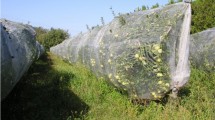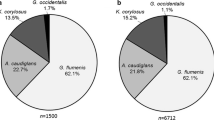Abstract
The establishment of predacious mites in commercial orchards may be accelerated by the transfer of pruned wood in winter and summer from donor orchards to release orchards. Following winter pruning, 3-year-old and older wood is collected and transported as soon as possible in bundles to a release orchard for distribution. If the release orchard is composed of dwarf trees, then one or two bundles of 5 kg each are placed vertically at the base of the trunk of every tree in the block (0.5 to 1 ha); if the trees are of standard size, then four or five bundles used. Following summer pruning, annual shoots and suckers are distributed immediately in a release orchard composed of dwarf trees by placing 12–15 branches on the foliage of fruit-bearing branches; if the release orchard is composed of standard trees, then 50 branches are used. The pruned wood should have 20–25 leaves and not less than one predator per leaf. The release orchard should have a light infestation (two or three mites per leaf) of pest tetranychids. These phytophagous mites would serve as food and help establish the predators. The release orchard grower should develop a pest management program based on the same groups of pesticides used in the donor orchard.
Access this article
We’re sorry, something doesn't seem to be working properly.
Please try refreshing the page. If that doesn't work, please contact support so we can address the problem.
Similar content being viewed by others
References
Blommers, L. (1994) Integrated pest management in European apple orchards.Annu. Rev. Entomol. 39:213–241.
Bostanian, N.J. and Belanger, A. (1985) The toxicity of three pyrethroids toAmblyseius fallacis (Garman) Acari: Phytoseiidae and their residues on apple foliage.Agric. Ecosyst. Environ. 14:243–250.
Bostanian, N.J., Belanger, A. and Rivard, I. (1985) Residues of four synthetic pyrethroids and azinphosmethyl on apple foliage and their toxicity toAmblyseius fallacis (Acari: Phytoseiidae).Can. Entomol. 117:143–152.
Bostanian, N.J. and Coulombe, L.J. (1986) An integrated pest management program for apple orchards in southwestern Quebec.Can. Entomol. 118:1131–1142.
Bostanian, N.J. and Herne, D.H.C. (1980) A rapid method of collecting arthropods from deciduous fruit trees.J. Econ. Entomol. 73:832–833.
Bostanian, N.J. and Larocque, N. (2001) Laboratory tests to determine the intrinsic toxicity of four fungicides and two insecticides to the predacious miteAgistemus fleschneri.Phytoparasitica 29:215–222.
Bostanian, N.J., Larocque, N., Chouinard, G. and Coderre, D. (2001) Baseline toxicity of several pesticides toHyaliodes vitripennis (Say) (Hemiptera: Miridae).Pest Manage. Sci. 57:1007–1010.
Bostanian, N.J., Lasnier, J. and Racette, G. (1999) Biological control of mites in Quebec apple orchards.Can. Fruit Grower 55:8–10.
Bostanian, N.J. and Racette, G. (1997) Residual toxicity of lambda-cyhalothrin on apple foliage toAmblyseius fallacis and the tarnished plant bug.Phytoparasitica 25:193–198.
Bostanian, N.J., Thistlewood, H. and Racette, G. (1998) Effects of five fungicides used in Quebec apple orchards onAmblyseius fallacis (Garman) (Phytoseiidae: Acari).J. Hortic. Sci. Biotechnol. 73:527–530.
Bostanian, N.J., Vincent, C., Hardman, J.M. and Larocque, N. (2004) Toxicity of indoxacarb to two species of predacious mites and a predacious mirid.Pest Manage. Sci. 60:483–486.
DeBach, P. (1964) Biological Control of Insect Pests and Weeds. Reinhold Publishing Corp., New York, NY.
Henderson, C.F. and McBurnie, H.V. (1943) Sampling technique for determining populations of the citrus red mite and its predators.U.S. Dep. Agric. Circ. 671.
Martin, J.E.H. (1977) The Insects and Arachnids of Canada. Collecting, Preparing, and Preserving Insects, Mites and Spiders.Agric. Agri-Food Can. Publ. 1643.
Nyrop, J.P., Kain, D.P., Minns, J. and Agnello, A. (1995) Improving the success of transferring the mite predatorTyphlodromus pyri from one orchard to another.Proc. N.Y. State Hortic. Soc. 140:6–10.
Prokopy, R., Wright, S., Mason, J., Nyrop, J., Wentworth, K. and Herring, C. (1997) Comparative level of establishment of releasedTyphlodromus pyri predatory mites in first-level and second-level IPM apple orchard blocks.Fruit Notes 62:6–8.
Provost, C., Coderre, D., Lucas, E. and Bostanian, N.J. (2003) Impact of lamda-cyhalothrin on intraguild predation among three mite predators.Environ. Entomol. 32:256–263.
SAS Institute (1994) SAS/STAT User’s Guide, vol. 2. SAS Institute, Cary, NC, USA.
Author information
Authors and Affiliations
Corresponding author
Additional information
http://www.phytoparasitica.org posting Aug. 31, 2005.
Rights and permissions
About this article
Cite this article
Bostanian, N.J., Lasnier, J. & Racette, G. A grower-friendly method to transfer predacious mites to commercial orchards. Phytoparasitica 33, 515–525 (2005). https://doi.org/10.1007/BF02981401
Issue Date:
DOI: https://doi.org/10.1007/BF02981401




